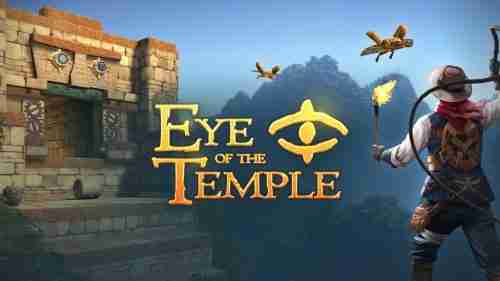Eye of the Temple is an interesting title, built almost single-handedly by developer Rune Skovbo Johansen on PCVR, and ported to Quest with Salmi Games. Eye of the Temple has you exploring an ancient temple, unlocking its gates, solving its puzzles, and making your way to its inner core to liberate the forces of light from the darkness that has taken over the temple.
Now if you’ve seen our impressions video or any other video about the game, you’ll know that its core selling point is its unique locomotion system that, as I said before, reminds me of the Impossible Spaces system used in Tea for God. The idea is that the entire game is played without any artificial locomotion. You don’t use thumbsticks to move, and you don’t use free movement or teleportation. It’s all done in room scale, cannot be played sitting down, won’t work if your space is too small, and relies entirely on messing with your head using moving blocks and rollers, making it feel like you’re traversing all kinds of distances while you’re really just taking small steps to the front, sides, and back.
Does this system work? Yes. It works brilliantly and, I’m tempted to say, flawlessly. It works so well, in fact, that you have to be careful since stepping off of moving blocks and off rollers subconsciously tempts your body to try to overcompensate for inertia and, more than once, almost had me fall over. I repeat, I’m a VR veteran and I almost fell over a couple of times. So, you’ve been warned; be careful.

The result of all this is that the game passes the ‘Yeah, but is it immersive!?’ test with flying colors. The movement system is, indeed, very immersive.
Step By Step
The gameplay itself is relavitely simple; you navigate your way around the temple, solving puzzles, unlocking doors, and activating a set of seven beacons to allow you to finally enter the inner chambers of the temple, where you can finally confront the great darkness, and save mankind from all kinds of evil things.
In your adventure, you’re armed with the whip I mentioned earlier and a torch. Did I mention Indiana Jones? I did in the impressions video, so I promise I won’t again. I’m sure every other video about this game has already hammered the Indy angle hard, so let’s not waste time on that.

Your whip, the developer promises, is ‘physically simulated’, and it does act more or less like you’d expect it to, but only unfurls, so to speak, when the game decides it would be of use. Although I don’t doubt the mechanics behind it, in practice, it’s a bit hit-and-miss, and chances are you’ll only get good at using it by the time you’ve reached the final levels. Initially, the whip is mainly used to pull levers that are too far for you to reach yourself, and the torch is mostly used to light up braziers, some of which unlock gates, activate mechanisms, or reveal parts of the backstory. There are a couple of sequences where you’ll also use it as a weapon, but this is not an action game.

There’s a cool blue bird – I think it’s a falcon – that follows you around throughout the game, and as the story progresses, you’ll grow to appreciate why. Enough of that! This is a no-spoiler zone.
As the game progresses, you’ll unlock one extra thing your whip can do, and it’s pretty cool and helps Eye of the Temple offer some variety in its puzzle design.
Hello Legoland
Visually speaking, the game’s graphics are good but not remarkable. There’s nothing here to compete with some of the better-looking games on Quest, but the art style is consistent and attractive enough to keep you immersed. However, it’s too consistent, the South American style that the game relies on is unchanged throughout. This is logically consistent since the game does all take place in ONE temple, but I would’ve appreciated some variety in overall style and textures. A few areas with distinctly different themes would have made a huge difference and surely could have been explained by some narrative device.

The audio design is very good, and the soundtrack by Claudi Martinez is very fitting, although somewhat generic. Although generally sedate and relaxing, it’s triggered by the context and gets more energetic and upbeat when more action is called for. Overall, it serves the game just as it should, as does the sound design.
Matters of Scale
Eye of the Temple takes about 4-5 hours to complete but squeezes out some extra longevity by offering speedrun challenges to gamers who enjoy those, and secret treasures to be found for completionists.

At $19.99 it’s about par for the course for this scale on Quest. As a puzzler, it offers a unique experience, but I also have to mention it has its ups and downs. It was great fun at the start, then started getting a bit dull as the gameplay and the environments started feeling samey, then it became more fun again when the whip gained an extra feature about halfway into the game, offering a little more variety in the nature of the puzzles. I’m also tempted to say that since the game has a couple of action sequences, perhaps a few more would also have upped the ante.
Eye of the Beholder
Eye of the Temple is an immersive puzzler that perhaps relies a bit too heavily on its locomotion system to keep you entertained. It’s rewarding, but brief, and could have used more variety. Having said that, I had a great time with the game, and despite a bit of a lull mid-run, the latter half kept me going, and I felt compelled to play it to the end.
Good stuff.







